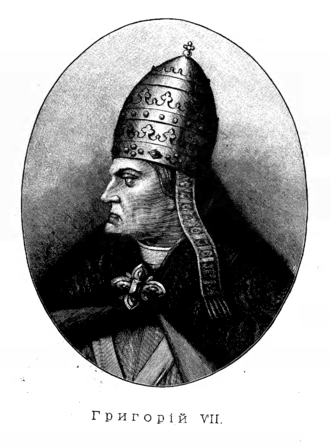From the eleventh to the thirteenth centuries, medieval Europe and the development of the Church saw rapid and radical change. After centuries of a move away from the archaic values of the desert fathers, the Church became embroiled in the political structure of Europe and became more and more intertwined with the secular world as the secular and spiritual worlds fought for power. How did this change come to be?
(At the beginning op this period TN) the Church did not rule itself; the highest papal offices were filled with nobility, or chosen by the nobility, to fulfil their own desires. The Church owned many lands in central Europe at this point, and control over it led to these struggles over authority. However, by the end of the thirteenth century the control of the Church had changed hands, with the majority of it being ruled by spiritual leaders, rather than kings’ men.(...) The Gregorian Reforms, issued at the end of the eleventh century, were the single, biggest reason that the change began. The Gregorian Reforms, which take their name from the reigning pope at the time, Pope Gregory VII, who instigated the reforms, sought a breaking away of the church from the secular society. Pope Gregory VII, and many of his contemporaries, felt that a return to the values of old were necessary to reform the Church back to what they believed to be pure.
Part of Gregory’s attacks on Church practices was that of clerical marriage, thereby encouraging a departure from secular life. Gregory also attacked, perhaps more importantly, given the change that followed, the practice of investiture within the Church, in all its various forms. This is another, yet more apparent, deviation from the secular society that had a hold over the Church at this point.... It seems that Gregory was trying to reinforce earlier attempts at a separation of church and state. Pope Nicholas II was the leader of the Church from 1058 to 1061, meaning that the Investiture Controversy was slowly building from at least the mid-eleventh century, but highly likely much longer.
(...) A form of capitalism in the social climate of the eleventh century was the incentive for gaining power. The theory of a rowing intellectualism in western Europe also has its merits; ‘The rise of the universities meant a further extension of ecclesiastical jurisdiction, since all formal education was regarded as a matter for churchmen.’
This blog quotes from the Thesis by Lori Firth, Hull University (2012): "A Comparison of the Cistercian and Knights Templar Orders, And the Personal Influence of Bernard of Clairvaux". Illustration shows Pope Gregory VII, source Wikipedia.
Support TemplarsNow™ by becoming a Patron, tipping us or buying one of our Reliable Books

No comments:
Post a Comment